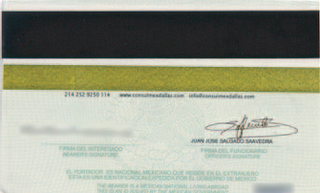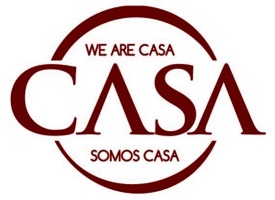Related Research Articles

New Haven is a city in New Haven County, Connecticut, United States. It is located on New Haven Harbor on the northern shore of Long Island Sound and is part of the New York City metropolitan area. With a population of 135,081 as determined by the 2020 U.S. census, New Haven is the third largest city in Connecticut after Bridgeport and Stamford, the largest city in the South Central Connecticut Planning Region, and the principal municipality of Greater New Haven, which had a total population of 864,835 in 2020. Prior to 1960, it was the county seat of New Haven County until the county governments were abolished that year.

The Matrícula Consular de Alta Seguridad (MCAS) is an identification card issued by the Government of Mexico through its consulate offices to Mexican nationals residing outside of Mexico. Also known as the Mexican CID card, it has been issued since 1871. The issue of the card has no bearing on immigration status in the foreign country they are residing in. The purpose of the card is to demonstrate that the bearer is a Mexican national living outside of Mexico. It includes a Government of Mexico issued ID number and bears a photograph and address outside of Mexico of the Mexican National to whom it is issued.
Reforming the immigration policy of the United States is a subject of political discourse and contention. Immigration has played an essential part in American history. Some claim that the United States maintains the world's most liberal immigration policy.

The Real ID Act of 2005 is an Act of Congress that establishes requirements that driver licenses and identification cards issued by U.S. states and territories must satisfy to be accepted for accessing federal government facilities and nuclear power plants and for boarding airline flights in the United States. The requirements include verification of the personal information presented when applying for the identification document, security features on the document, and electronic sharing of databases between states. The act also made various modifications to U.S. immigration law regarding asylum, border security, deportation, and certain work visas.

John DeStefano Jr. is an American politician who served as the 49th mayor of New Haven, Connecticut, from 1994 until 2014. He was the Democratic nominee in 2006 for Governor of Connecticut, unsuccessfully challenging incumbent Republican Governor M. Jodi Rell. He was also the named defendant in the landmark 2009 U.S. Supreme Court case of Ricci v. DeStefano. John DeStefano is the son of a New Haven police officer. John and his wife Kathy DeStefano met at the University of Connecticut as undergraduates, where he also earned a Masters in Public Administration. Kathy DeStefano is a first grade teacher in West Haven, Connecticut, and they are the parents of two adult sons.

The Development, Relief, and Education for Alien Minors Act, known as the DREAM Act, is a United States legislative proposal to grant temporary conditional residency, with the right to work, to illegal immigrants who entered the United States as minors—and, if they later satisfy further qualifications, they would attain permanent residency.

The Hong Kong identity card is an official identity document issued by the Immigration Department of Hong Kong. According to the Registration of Persons Ordinance, all residents of age 11 or above who are living in Hong Kong for longer than 180 days must, within 30 days of either reaching the age of 11 or arriving in Hong Kong, register for an HKID. HKIDs contain amongst others the name of the bearer in English, and if applicable in Chinese. The HKID does not expire for the duration of residency in Hong Kong.

Foreign nationals (aliens) can violate US immigration laws by entering the United States unlawfully or lawfully entering but then remaining after the expiration of their visas, parole, TPS, etc. Illegal immigration has been a matter of intense debate in the United States since the 1980s.

Illegal immigration is the migration of people into a country in violation of that country's immigration laws, or the continuous residence in a country without the legal right to. Illegal immigration tends to be financially upward, from poorer to richer countries. Illegal residence in another country creates the risk of detention, deportation, and/or other sanctions.
A sanctuary city is a municipality that limits or denies its cooperation with the national government in enforcing immigration law.
The Comprehensive Immigration Reform Act of 2007 was a bill discussed in the 110th United States Congress that would have provided legal status and a path to citizenship for the approximately 12 million undocumented immigrants residing in the United States. The bill was portrayed as a compromise between providing a path to citizenship for undocumented immigrants and increased border enforcement: it included funding for 300 miles (480 km) of vehicle barriers, 105 camera and radar towers, and 20,000 more Border Patrol agents, while simultaneously restructuring visa criteria around high-skilled workers. The bill also received heated criticism from both sides of the immigration debate.

CASA is a Latino and immigration advocacy-and-assistance organization based in Maryland. It is active throughout the state, but has major foci in Prince George's County, Montgomery County and Baltimore. CASA influences Maryland politics on a wide range of policies, ranging from law-enforcement to education. It also has offices in Virginia, Pennsylvania, and Georgia.
Oklahoma House Bill 1804, officially known as the Oklahoma Taxpayer and Citizen Protection Act 2007, is a strict anti-illegal immigration law introduced by State Representative Randy Terrill, a Republican from Moore, OK.
Consular identification (CID) cards are issued by some governments to their citizens who are living in foreign countries. They may be used, for example, by an embassy to allow its citizens to vote in a foreign country. Some jurisdictions accept them for some identification purposes. They are not certifications of legal residence within foreign countries, so CID card holders could be legal or illegal aliens.
In the United States, a cityidentification card is a form of identification card issued by a municipality, such as a city, rather than a state or federal government. Under federal law, cities may issue their own identification cards as they see fit, and do not have to consider the immigration or criminal status of an applicant before doing so. New Haven, Connecticut, issued the first municipal identification cards in the United States, the Elm City Resident Card, in 2007. On January 15, 2009, the city/county of San Francisco launched the SF City ID Card, a municipal identification card program modeled after New Haven's. Other cities that issue identification cards include Asbury Park, New Jersey, and Washington, D.C.. In Mercer County, New Jersey, a community ID card is being issued by a local non-profit organization with the endorsement of various law enforcement agencies.
There are thought to be over half a million undocumented immigrants residing in New York City. They come from many parts of the world, especially Latin America, Asia, Eastern Europe, and the Caribbean. About 70% of them have paid work, in catering, construction, retail, driving, cleaning, and many other trades; at least in catering, their wages tend to be lower than those of comparable workers.
The SF City ID Card is a municipal identification card program operated by San Francisco, California for residents of the city-county, regardless of their immigration status. The cards also do not specify the person's gender, to assist transgender individuals who often have difficulty with identification documents.
Alabama HB 56, titled the Beason-Hammon Alabama Taxpayer and Citizen Protection Act is an anti-illegal immigration bill, signed into law in the U.S. state of Alabama in June 2011.
As of July 1, 2022, 18 U.S. states, the District of Columbia, and Puerto Rico issue driver's licenses or permits to some or all of the population residing without inspection in the United States. State laws permitting this are on the books in California, Colorado, Connecticut, Delaware, Hawaii, Illinois, Maryland, New Mexico, Nevada, Massachusetts, New York, New Jersey, Oregon, Utah, Vermont, Virginia and Washington.
Federal policy oversees and regulates immigration to the United States and citizenship of the United States. The United States Congress has authority over immigration policy in the United States, and it delegates enforcement to the Department of Homeland Security. Historically, the United States went through a period of loose immigration policy in the early-19th century followed by a period of strict immigration policy in the late-19th and early-20th centuries. Policy areas related to the immigration process include visa policy, asylum policy, and naturalization policy. Policy areas related to illegal immigration include deferral policy and removal policy.
References
- 1 2 Holtz, Jeff (16 September 2007). "This Summer's Surprise Hit: An Elm City ID". The New York Times . Retrieved 16 February 2009.
- ↑ "Courage in Elm City". The New York Times. May 22, 2008. Retrieved August 29, 2011.
- 1 2 3 Bailey, Melissa (5 June 2007). "City ID Plan Approved". New Haven Independent . Retrieved 16 February 2009.
- ↑ Bass, Paul (25 October 2006). "Immigrant's Wake". New Haven Independent. Retrieved 16 February 2009.
- 1 2 3 Bass, Paul (31 May 2007). "Immigration Encounter on Church Street". New Haven Independent. Retrieved 16 February 2009.
- ↑ Bailey, Melissa (13 December 2006). "City To Immigrants: Fear No More". New Haven Independent. Retrieved 16 February 2009.
- ↑ Bass, Paul (19 October 2005). "A City to Model". New Haven Independent. Retrieved 17 February 2009.
- ↑ Bailey, Melissa (20 December 2006). "Mayor Pledges Municipal ID Cards, Take 2". New Haven Independent. Retrieved 16 February 2009.
- ↑ Bailey, Melissa (8 May 2007). "City Unveils a New ID". New Haven Independent. Retrieved 16 February 2009.
- ↑ Aarnsdorf, Isaac. "Elm City Takes ID Show On The Road". Yale Daily News. Retrieved 28 June 2014.
- ↑ Bernstein, Nina (23 July 2007). "Promise of ID Cards Is Followed by Peril of Arrest for Illegal Immigrants". The New York Times. Retrieved 16 February 2009.
- ↑ Kral, Georgia (18 December 2007). "Questions on Illegal Immigrants Lead to Raid on Nonprofit's Office". The New York Times. Retrieved 16 February 2009.
- ↑ "How to Get Your Official San Francisco ID Card, Program Kicks Off Today". San Francisco Citizen. January 15, 2009. Retrieved August 29, 2011.
- ↑ Bernstein, Nina (24 July 2007). "Bill for New York City ID Card To Be Introduced by Councilman". The New York Times. Retrieved 16 February 2009.
- ↑ Editorial (22 May 2008). "Courage in Elm City". The New York Times. Retrieved 16 February 2009.
- ↑ Bray, Aaron (June 26, 2008). "City may keep names of ID-card holders private, FOIC rules". Yale Daily News. Archived from the original on 2008-10-11.